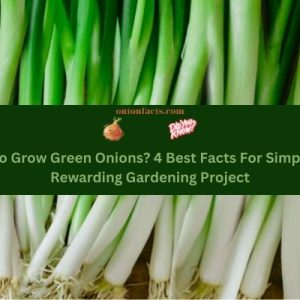Green onions, also known as scallions or spring onions, are versatile and flavorful additions to a wide range of dishes. Growing your green onions at home can be a rewarding and cost-effective way to ensure a fresh and abundant supply for your culinary endeavors. In this comprehensive guide, we will explore the step-by-step process of growing green onions, from selecting the right variety to harvesting and storing your bountiful crop.
Choosing the Right Variety:
Before diving into the cultivation process, it’s essential to choose the right variety of green onions for your home garden. Common varieties include Evergreen, Red Beard, and Tokyo Long White. Consider factors such as taste preference, local climate, and available space when making your selection.
Getting Started with Seeds or Sets:

Green onions can be grown from seeds or sets, which are small onion bulbs. Growing from seeds allows for a wider variety of options, while sets provide a quicker start to the growing process. If you choose to start from seeds, sow them directly into the soil or begin indoors before transplanting seedlings into the garden. For sets, simply plant them directly into the soil at the recommended spacing.
Green onions thrive in well-draining soil with a slightly acidic to neutral pH. Ensure that the chosen location receives plenty of sunlight, as green onions require at least 6 hours of sunlight daily. Adequate sunlight promotes strong growth and the development of flavorful, tender stalks.
Planting and Spacing:
When planting green onions, sow seeds or sets about half an inch deep in rows spaced 12 to 18 inches apart. If planting in containers, ensure they are deep enough to accommodate the growth of the onions’ root systems. Proper spacing helps prevent overcrowding, allowing each plant to receive sufficient nutrients and sunlight.
Consistent and adequate watering is crucial for the successful growth of green onions. Keep the soil consistently moist but not waterlogged, as excessive moisture can lead to rot. Additionally, incorporate a balanced fertilizer into the soil before planting and consider applying a nitrogen-rich fertilizer during the growing season to promote leafy growth.
Weeds can compete with green onions for essential nutrients and stifle their growth. Regularly inspect the garden for weeds and promptly remove them to ensure your green onions have the best possible growing environment. Mulching around the plants can help suppress weed growth and retain soil moisture.
While green onions are relatively resistant to pests, occasional challenges may arise. Keep an eye out for common pests such as aphids, onion maggots, and thrips. Insecticidal soaps or neem oil can be effective, natural solutions for managing pests without harming the plants.
Harvesting Green Onions:

The timing of harvesting green onions depends on personal preference and the desired size of the onions. Generally, green onions can be harvested when the stalks reach a height of 6-8 inches. Use a sharp pair of scissors or garden shears to cut the stalks just above the soil level. Harvesting can be done continuously, allowing for a staggered and prolonged harvest throughout the growing season.
Utilizing Trimmed Stalks:
Don’t discard the trimmed green onion stalks! The white and light green parts can be used fresh in salads, soups, or as a garnish, while the tougher green tops are excellent for flavoring stocks and broths. This utilization ensures minimal waste and maximizes the culinary potential of your home-grown green onions.
Freshly harvested green onions can be stored in the refrigerator for up to a week. To extend their shelf life, consider placing them in a jar with water and covering the tops with a plastic bag. Alternatively, green onions can be chopped and frozen for long-term storage, preserving their flavor for use in future dishes.
Advanced Tips for Growing Healthy Green Onions:

- Succession Planting: To ensure a continuous harvest, consider succession planting. Sow new seeds every two to three weeks throughout the growing season. This method ensures a constant supply of fresh green onions rather than a single, large harvest.
- Companion Planting: Planting green onions alongside other vegetables can offer benefits like pest control and enhanced growth. They are known to repel pests like aphids and carrot flies, making them excellent companions for carrots, tomatoes, and lettuce.
- Soil Amendments: Enhance the soil with well-rotted compost or aged manure before planting. This improves soil structure, nutrient content, and water retention. Adding organic matter annually contributes to the long-term health of your green onion bed.
- Container Gardening: Limited on garden space? Green onions are well-suited for container gardening. Choose a deep container, at least 6 inches deep, and plant them with the recommended spacing. This allows for easy mobility and placement in areas with ample sunlight.
- Mulching: Apply a layer of organic mulch, such as straw or shredded leaves, around the green onion plants. Mulching helps retain soil moisture, suppresses weed growth, and moderates soil temperature, promoting optimal growing conditions.
Conclusion:
Growing green onions at home is a fulfilling and straightforward process that rewards you with a fresh and flavorful ingredient for your culinary creations. By choosing the right variety, providing optimal growing conditions, and practicing proper care, you can enjoy a bountiful harvest of green onions throughout the growing season. Whether you have a sprawling garden or limited space for containers, cultivating green onions is a versatile and accessible endeavor that enhances the taste and sustainability of your home-cooked meals.







